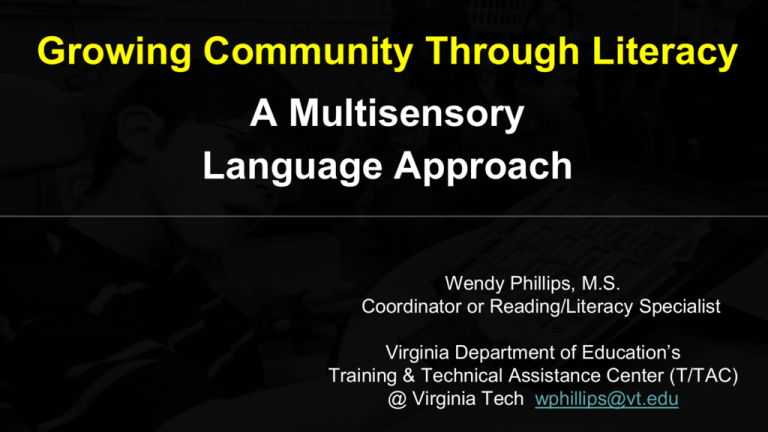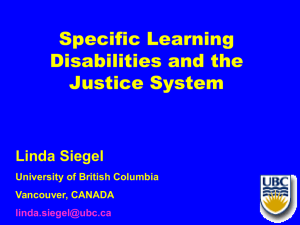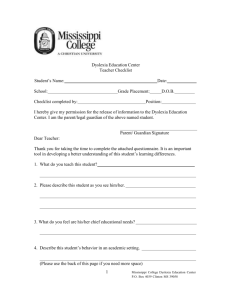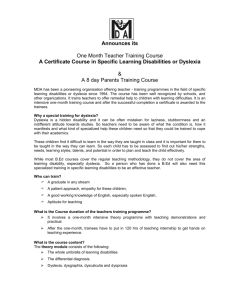Wendy Phillips: Multisensory Approach
advertisement

Growing Community Through Literacy A Multisensory Language Approach Wendy Phillips, M.S. Coordinator or Reading/Literacy Specialist Virginia Department of Education’s Training & Technical Assistance Center (T/TAC) @ Virginia Tech wphillips@vt.edu Today’s Meet chat platform https://todaysmeet.com/NRVRC https://www.ttac.vt.edu What is T/TAC? The mission of the Training & Technical Assistance Center (T/TAC) is to: ➔ improve educational opportunities and contribute to the success of children and youth with disabilities (birth–22 years) ➔ increase the capacity of schools, school personnel, service providers, and families to meet the needs of children and youth with disabilities ➔ foster the state improvement goals for personnel development, which address improving the performance of children and youth with disabilities So How Do We Meet Our Mission? Professional Development Regional Trainings Individual Consultation Library Loans Information Services Referral Services Free of Charge What’s Available in the Lending Library? ● print materials ● videos ● computer software ● assistive technology devices ● augmentative communication devices ● iPads, chromebooks, tablets ● books for professional development ● reading, writing & math programs ● leveled books ● assessment kits ● assistive technology Kits Featured Literacy Items Available for check-out @ T/TAC @ VT Video Introduction The Orton-Gillingham instructional approach is a direct, systematic approach to teaching language structure for reading remediation. It is designed to address the needs of struggling readers who have difficulty with reading, spelling, and writing including those with a specific learning disability such as dyslexia. How is dyslexia defined in Virginia? "Specific learning disability" means a disorder in one or more of the basic psychological processes involved in understanding or in using language, spoken or written, that may manifest itself in the imperfect ability to listen, think, speak, read, write, spell or to do mathematical calculations, including conditions such as perceptual disabilities, brain injury, minimal brain dysfunction, dyslexia, and developmental aphasia. From the Virginia Administrative Code: http://leg1.state.va.us/cgi- bin/legp504.exe?000+reg+8VAC20-81-10 These difficulties typically result from a deficit in the phonological component of language that is often unexpected in relation to other cognitive abilities and the provision of effective classroom instruction. Secondary consequences may include problems in reading comprehension and reduced reading experience that can impede growth of vocabulary and background knowledge. (§ 22.1-213 of the Code of Virginia; 34 CFR 300.8(c)(10)) Dyslexia is distinguished from other learning disabilities due to its weakness occurring at the phonological level. Dyslexia is a specific learning disability that is neurobiological in origin. It is characterized by difficulties with accurate and/or fluent word recognition and by poor spelling and decoding abilities. Read sample from book Dyslexia (or specific reading disability) represents one of the most common problems affecting children and adults; in the United States the prevalence of dyslexia is estimated to range from 5% to 17%, with up to 40% of school-age children reading below grade level (Shaywitz & Shaywitz, 2004). SLD is the highest incidence of students receiving special education services (42 percent of the 5.7 million school-age children with all kinds of disabilities). There are 2.4 million American public school students (approximately 5 percent of the total public school enrollment) identified with SLD under the Individuals with Disabilities Education Act. Two-thirds (66 percent) of students identified with SLD are male, while overall public school enrollment is evenly split between males and females. https://www.ncld.org/reports-and-studies/2014-state-of-ld/ The International Dyslexia Association (IDA) indicates that 5 to 20% of the population have some of the symptoms of dyslexia. Further, IDA indicates that of those eligible for special education services as having a learning disability, 85% have primary learning disability in reading or language processing. (Moats and Dakin, 2012) http://eida.org/dyslexia-basics) Red Flags of Dyslexia Family history Never learned nursery rhymes Never crawled Late in speaking/speech problems Delayed potty training Can not rhyme Can not tie their shoe Can only SING the alphabet Difficulty following directions Frequent ear infections Auto-immune deficiency disorders Reversals after 1st grade Famous people with Dyslexia JFK Robin Williams Thomas Edison Patricia Polacco Henry Winkler Jay Leno Whoopi Goldberg Walt Disney Those with dyslexia experience difficulty at the phonological processing level. Phonological processing involves the taking in, manipulating, and storing of phonemes. Phonological awareness is the ability to identify, think about, and manipulate the parts of words, including syllables, onsets and rimes, and phonemes. Phoneme segmentation is at the heart of reading and spelling (Moats, 2009). Reading instruction must contain the five components of reading (Phonemic Awareness, Phonics, Fluency, Vocabulary, and Comprehension) as outlined in the National Reading Panel’s report (National Institute of Child Health and Human Development, 2000) to meet the standards set out in IDEA 2004, ESEA 2001 and the USED waivers of 2012. Hennessy (2012) suggests that teachers of reading consider the strands of the reading rope Academy of OrtonGillingham Teaching Materials 7 Tenets of the Orton-Gillingham Approach Multisensory (see, say, do) Direct & Explicit (tell what each sound says) Language Based (Anglo-Saxon rules) Structured, Sequential & Cumulative (cards) Diagnostic/Prescriptive (data informs instruction) Cognitive (logic) Emotionally Sound (positive cycle) Multisensory Sample Lesson Plan Symbol to Sound (salmon/white cards) Alphabet Sound to Symbol (yellow cards) Review Words for Reading Review Words for Spelling New Words for Reading New Words for Spelling Handwriting Oral Reading Plans should be multisensory: Are you tapping into the various learning pathways (visual, auditory, kinesthetic/tactile) when teaching your students? Are they able to “see,” “hear” & “feel” what you are teaching? Plans should be cognitive: Do your lessons teach your students the various rules of our language & how to apply those rules to reading, writing & spelling? Phonetic Concepts & Rules Plans should be diagnostic: Are you consistently progress monitoring your student's performance to assess areas of need & responsiveness to intervention? OG Based Programs Trace, Copy, Cover, Closed Procedure (while standing) • Teacher models a letter (8” tall) while naming it outloud and student traces it 3 times, while naming it • Student copies it 3 times, while naming it • Model is covered, and student forms the letter from memory, while naming it • Student forms letter with eyes averted/closed Moats (2009) notes that the closed syllable is the most common spelling unit in English and accounts for just under 50 percent of the syllables in running text. Closed syllables are the first referenced for reading instruction within the curriculum frameworks (SOL 1.6) S.O.S Simultaneous Oral Spelling ❏ Teacher says the word ❏ Student repeats the word ❏ Student segments the sounds and spells the word aloud ❏ Student writes the letters while saying each letter ❏ Student reads the word FLOSS Rule When /f/ /l/ /s/ (or /z/) is heard after a short vowel at the end of a one-syllable word, it is spelled with a double ff, ll, ss or zz. i.e. puff, hill, fluff, doll, cliff, sell, sniff, drill, miss, buzz, boss, jazz, less, fuzz, guess Rabbit Rule (VC-CV) When 2 consonants come between 2 vowels, split between the consonants i.e. napkin, cactus, bandit, tablet Tiger Rule (V-CV) When a consonant comes between 2 vowels, try to split it after the vowel to make an open syllable Tiger screams (TI-ger!) i.e. remote, female, human Camel Rule (VC_V) If it doesn’t make a word after the vowel, split it after the consonant The 1st syllable will be closed Tigers are louder than camels (Camels can not scream their name, only their sound) i.e. panic, credit, profit, rapid, planet Orton Gillingham Resources Cards a,e,i,o,u Isolated Sound Record Sheet Skills Checklist Jewel Case Words Salmon & White Cards Floss Rule Salmon & White Cards Multisensory Resources Multisensory Apps Article Other Resources Dyslexia Resources Decoding Dyslexia Virginia - http://www.dysva.org/ International Dyslexia Association – http://eida.org/ Virginia Branch of the International Dyslexia Association – http://vbida.org/ Learning Disabilities Association of America - http://ldaamerica.org/ National Center for Learning Disabilities - http://www.ncld.org/ AIM-VA Accessible Instructional Materials Free accessible textbooks & other reading materials for eligible K-12 students with IEP’s in VA AIM-VA Superintendent’s Memo #174-13 Evaluation







